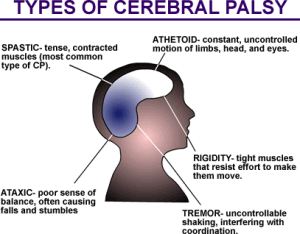 Cerebral palsy is an umbrella term for a group of disorders affecting movement and muscle tone or posture. There is no cure yet, and medical marijuana and cerebral palsy have not been well-researched in the past due to prohibitionist laws. Nevertheless, many patients have found that marijuana for cerebral palsy relieves many of their symptoms, such as pain, seizures and spastic movements.1
Cerebral palsy is an umbrella term for a group of disorders affecting movement and muscle tone or posture. There is no cure yet, and medical marijuana and cerebral palsy have not been well-researched in the past due to prohibitionist laws. Nevertheless, many patients have found that marijuana for cerebral palsy relieves many of their symptoms, such as pain, seizures and spastic movements.1
Types and Causes of Cerebral Palsy
Cerebral palsy, or CP, is divided into four main groups: dyskinetic, spastic, ataxic and mixed. Those with dyskinetic CP find it difficult to sit and walk, due to the inability to control their hands, feet, arms and legs. Their muscle tone can change dramatically even within one day, switching from being too loose to too tight.
Spastic CP is the most common, affecting around 80 percent of people with CP, and affects different areas of the body. These people have muscles that are quite stiff, thus their movements are difficult and awkward.
Those with ataxic CP have difficulty with coordination and balance, and may walk unsteadily. Things such as writing or reaching for things may be challenging as well. Those with mixed CP have one or more types, with spastic-dyskinetic CP being the most prevalent.2
In the past, scientists believed that cerebral palsy was caused by lack of oxygen to the baby’s brain during birth, but they now think this to be a rare cause. The main cause in now thought to be brain damage that occurs in utero, within a month after birth or during that first critical year of life while the baby’s brain is still developing; the latter is usually due to an infection.2 However, researchers have discovered a significant genetic component to the disorder that was previously unknown.3
Medical Marijuana and Cerebral Palsy
While there is a paucity of research into medical marijuana for cerebral palsy, there have been a few studies that point to the efficacy of the cannabis plant in alleviating the painful and debilitating symptoms of the disorder.
One of these was a study done with 83 men suffering from CP. The patients were given 23 different medications to try, including cannabis. At the end of the study, the researchers reported that the patients experienced the most relief from their symptoms with cannabis, yet ironically, only five percent of them had ever used it previously.4
An Israeli study looked at the effects of combinations of CBD and THC in children with various motor disorders. Traumatic brain injury was the cause of complex motor disorder in one child, while five others had a neurogenetic syndrome and 19 had CP. Researchers used CBD and THC in ratios of either 6:1 or 20:1 CBD-to-THC, and found that the higher ratio of CBD produced relief from constipation, while the ratio containing more THC improved sleep. Spasticity was also reduced with small doses of THC, and the researchers also reported that all the children experienced improvement in mood and appetite.5
Any and all studies into the efficacy of medical marijuana for cerebral palsy is extremely important. But the Israeli study using CBD-dominant cannabis, and future studies that show similar positive results, may be of particular benefit to parents and caregivers of children with CP, as most are reluctant to give their children much, if any, THC.
And of course, for both adults and children who suffer from CP, a natural medication like cannabis is far safer than the pharmaceuticals usually given for the condition, such as gabapentin, an anticonvulsant. Gabapentin has potentially life-threatening side effects such as depression and suicidal thoughts, and multiorgan hypersensitivity.6
If You’re Ready to Try It
If you live in a state where medical cannabis is legal, you might want to try it for yourself. Even if cerebral palsy specifically is not a qualifying condition in your state, the legislation nevertheless might contain a broader provision; language which would allow doctors to recommend medical marijuana for diseases and disorders not otherwise specified. Check with your doctor or find one who has experience in this area.
If your state laws do not contain broad provisions for cannabis or won’t allow for it at all, or you are trying to help a child, you may want to try CBD. Even children can easily take CBD medication, as CBD (and THC) come in many forms besides flower and oil. Oral mucosal CBD sprays, transdermal patches, and even baked goods, chocolate and gummies can be found.
Start by checking our map to see what the current laws are in your state.
References
- Cerebral Palsy and Medical Marijuana. Cerebral Palsy Guidance. Medically Reviewed and Edited by Gina Jansheski, M.D.
- What Is Cerebral Palsy. Centers for Disease Control and Prevention
- Cerebral Palsy: Researchers Uncover Evidence of Genetic Causes
- Survey Results of Pain Treatments in Adults with Cerebral Palsy. American Journal of Physical Medicine & Rehabilitation. 90(3):207-216, MARCH 2011. Adam T. Hirsh, PhD, Anna L. Kratz, PhD, […], and Mark P. Jensen, PhD
- Medical Cannabis in Children with Complex Motor Disorders. June 2017. European Journal of Paediatric Neurology 21(1):e219
- Can Marijuana Help Treat the Symptoms of Cerebral Palsy?